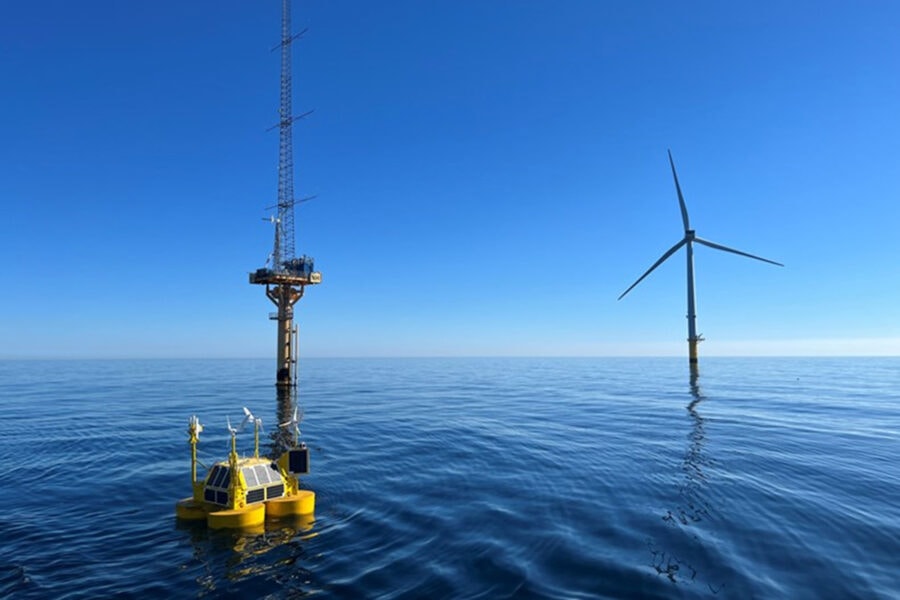A proposed expansion of the Ossian wind farm off the east coast of Scotland using floating technology would make it one of the top five largest floating offshore installations in the world, reports Tim Oliver.
An international partnership of leading Scottish renewable energy developer SSE Renewables, Japanese conglomerate Marubeni Corporation and Danish fund management company Copenhagen Infrastructure Partners has identified an increase in the potential overall capacity of the wind farm from 2.6GW to up to 3.6GW.
The proposed floating offshore windfarm (OWF) is set to be located across 858km2 of seabed in waters off the east coast of Scotland. It will be capable of powering almost six million Scottish homes and offsetting around 7.5m tonnes of carbon emissions each year, says SSE Renewables.
The company says that when the project is completed, it will be amongst the world’s largest floating offshore wind farms, ‘positioning Scotland as a global leader in floating offshore wind technology’.
David Willson, senior project manager at Ossian, said: “We are excited that through further technical assessment of our project area, we now believe Ossian could provide an even greater renewable electricity output.
“If realised, this change would position the project among the top five largest floating projects in the world, demonstrating its epic scale.
“We will now work with our stakeholders and regulators to secure the appropriate consent so that the full potential of the Ossian wind farm project can be realised.”
Technical equipment is now acquiring data at two locations at the Ossian site to measure wind speed and direction to help determine the best locations and positions for turbines.

A Crown Estate Scotland map showing the position of the ScotWind east coast wind farms. The Ossian wind farm is number 2.
David Willson added: “The surveys at Ossian appear to have shown that the area is ideal for floating wind, and this is enabling the expansion of the farm. I wouldn’t be surprised to see some of the other wind farms expanded.
“I also feel that floating wind farms like Ossian, where it is likely that all the turbines on their floats are connected to a central substation that could also be floating, may be a lot easier to expand.”
Raymond Hall, renewable energy policy officer at the Scottish White Fish Producers’ Association, who liaises with the offshore renewables industry, said that floating wind farms like Ossian present a challenge because they are effectively no-take zones.
But he also points out that because of their greater efficiency in producing power, they may be able to reduce the number of offshore sites needed, and thus benefit the industry.
He said both the fishing and offshore renewables industries require a lot of sea space to allow their business models to work, and therefore innovation will be key for both industries to co-exist.
“Maximising power output from the same spatial footprint of offshore wind farms would go a long way to achieving government targets, without the requirement for any additional offshore wind development areas,” he told Fishing News.
“Although this announcement will provide some additional challenges to the fishing industry, there are many positives to be taken from SSE’s decision to increase power output within the spatial footprint they have leased from Crown Estate Scotland.
“The Ossian OWF will be a floating wind farm, possibly using catenary mooring systems, which in effect will make it a no-take zone for most, if not all, types of fishing methods.
“Project design is not available yet – however, I would assume that the offshore substations will increase, as will the number of export cables making landfall, once grid connection has been identified.
“This will cause concern, from a navigational perspective, due to the increased number of substations and export cables as well as disruption during the construction phase of the Ossian project.”
He emphasised that a lot was still unknown about the effects of offshore wind development on the ecosystem and the marine environment. “It is imperative that Ossian and all other developers strive to address these unknowns through robust scientific evidence,” he said.
“Electromagnetic fields and their influence on migratory crustaceans, and effects on finfish and spawning grounds, are of deep concern to the fishing industry. These influences are a greater concern with floating wind farms because the array cables travel through the water column before reaching the seabed, where they will perhaps be buried.”
Raymond Hall said that the Round 3 and ScotWind developments currently have the potential to generate 38.634GW if they all ultimately become operational.
“Ideally it will be good if we can achieve our net-zero target with the sites that have already been allocated and get as much power out of these sites as possible, so we don’t have to go to the next round. But we don’t know if this is possible because the government change the goalposts all the time.
“If 15 of the ScotWind developments were to align with the Ossian model by increasing output by 1GW whilst remaining within their spatial footprint, potential output could increase to 56.634GW.
“Target goals can be achieved, with the aid of technology, without using any more valuable sea space. The spatial squeeze pressure is increasing year on year – therefore if developers, Crown Estate Scotland and the Scottish government really want to see offshore wind and the fishing industry co-exist, it is time to release some of that pressure by welcoming technical development.”
This story was taken from the latest issue of Fishing News. For more up-to-date and in-depth reports on the UK and Irish commercial fishing sector, subscribe to Fishing News here or buy the latest single issue for just £3.30 here.








